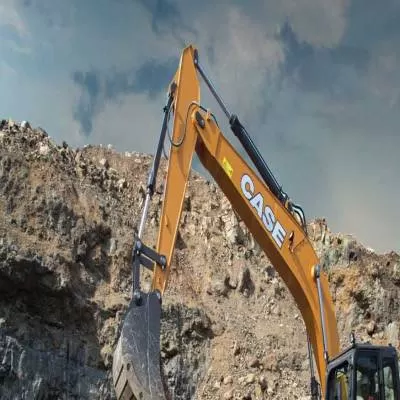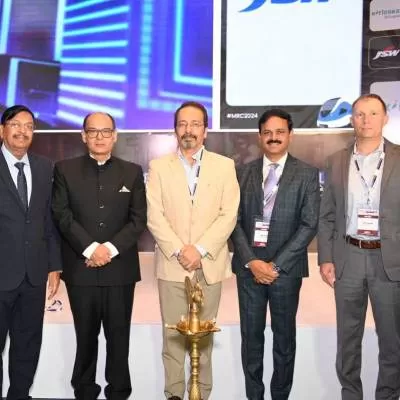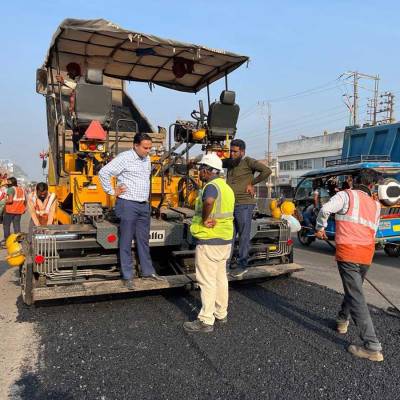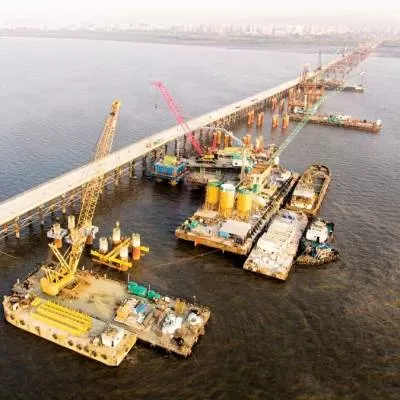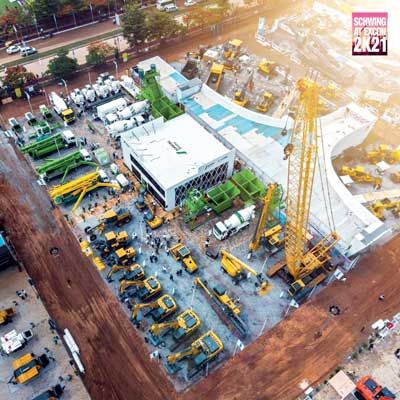Pace corridor
Mina Salman Interchange traced the path for Afcons to reinforce its presence in the Middle East. After having already worked in countries like Oman, Dubai, Yemen, Qatar, Iraq and Jordon, this project adds Bahrain to the company's illustrious client list in the Middle East. Afcons bagged the Rs 290.50 crore project in 2011 as part of the Strategic Roads Master Plan.
The master plan
The project includes the construction of seven span bridges with a two-lane carriageway and an underpass with three lanes on each side. Besides these, there will be asphalt reconstruction and a new road of approximately 80,050 sq m, varying from two to five-lane carriageway and the construction of slip lanes at Sheikh Bin Salman Highway and Al Fateh Highway. Earthworks, storm and sewer drainage, TSE and water distribution network, pumping stations, footpaths, asphalt paving, pavement markings and signage, street lighting and safety fences are major elements included in it.
Areas of improvement
As an integral part of the Bahrain Economic Vision 2030, the interchange is expected to significantly improve the traffic along the main trade corridor. According to Bahrain ministry sources, more than 74,000 vehicles, 24 per cent of which are heavy vehicles, pass through the junction daily. K Subrahmanian, Managing Director, Afcons, trills, "Half of the number of vehicles bound for Manama, Juffair and Exhibition Road use the interchange underlining its importance."
A pinch of success
Afcons tasted success in the initial stages of the project itself. The company's traffic diversion plan was highly appreciated by the Traffic Authority of Bahrain and the Ministry of Works. Much to the ministry's delight, the detention time at the junction was reduced from 30 minutes to 5 minutes. Two gantries were erected on North-West and South-West road for smooth flow of traffic during the construction of the main flyover. It is believed that the driving time between King Fahad Causeway and Khalifa Bin Salman Port will reduce to 18 minutes from the existing 38 minutes.
Major highlights
Dewatering: With the water table being only 1.5 m from ground level and seashore about 0.5 km from site, controlling ground water was a challenging task. Well points were drilled every 1 m at two vertical levels on either sides of underpass spanning 665.6 m and round the clock dewatering ensured to control ground water. Few units with deep wells have been installed as a contingency measure. Some deeper units have continuous seepage of water, which has been arrested by installing the subsoil drainage system locally to divert the flow in to the side drains.
Waterproofing system: To reduce the effect of saline ground water and to avoid water capillarity through the concrete pores, specialised waterproofing system has been used in the underpass construction. This specialised system, known as compartment system, uses water bars, welded double layer PVC sheet membrane and injectable pipes instead of conventional bitumen laminated membrane.
Double height staging: Since a part of the flyover passes across the underpass, double height staging was erected to support the deck slab construction.
Thermocouples: These were used in temperature monitoring of large concrete pours.
Sheet piles: For speedy and obstruction-free construction of the underpass, sheet piles have been installed throughout the underpass, supported by anchors in the place of struts.
Innovative measures
Challenges were faced in the underpass shoring works near the gantry - constructed over the diversion road for flyover construction - where it was required to drive sheet piles close to less than 1 m from the gantry foundation. Here pre-drilling was done on the sheet pile line to reduce vibration. Another challenge was the limited space availability between the gantry and sheet piles for the vibro hammer to operate. This difficulty, too, was overcome by applying vibration from a direction parallel to the sheet head by welding end plates on top of sheets.
Predrilling was also done near the water transmission pipelines to reduce vibration resulting from sheet pile operation. Warning gantries showing restricted height clearance of 5.5 m were installed on site at three locations to prevent accidents or damages to the gantry deck support installed for constructing the flyover.
In order to progress the flyover deck slab at maximum available fronts, the casting sequence was revised with 5 m gaps for post tensioning segments of different stages. After post tensioning, these gaps were completed in shorter durations. Base slabs were cast in two segments to get more work front. Ramps were made from top of the base slabs (depth varies from 0.6 m to 2.8 m) to the ground level at a few places for early completion of works.
Also, dewatering pumps were required to be installed in the underpass at a few locations where it would require frequent shifting to progress the construction of underpass wall, also causing inconvenience to the workforce. Hence, pumps were placed on an elevated platform welded on to the sheet piles at a certain height from ground level thereby increasing the efficiency of manpower.
Cost of protection and retaining 300 mm dia-water line during underpass excavation was eliminated by requesting the Water Distribution Directorate to increase the pump's capacity whereby bypass arrangement could be removed. This eliminated the requirement to retain and protect the pipeline during underpass excavation.
Further, truss arrangement has been installed to support the Live Sewer force main, which was supposed to be removed prior to starting the central portion of the Underpass by commissioning the pumping station. However, this commissioning is getting delayed due to various factors. The truss has been installed to support the sewer line, which will facilitate the construction of the underpass in the central portion. This will help avoid the expected delay of four and a half months.
The easy road
Once complete, the underpass will provide a hassle-free ride between King Fahad Causeway and the new Sheikh Khalifa bin Salman Port and the overpass will provide access to Al Fateh Highway from Sh Isa Bin Salman Highway. The interchange, Afcons first venture in Bahrain, is expected to be operational before time.
The project in numbers
- 4,760 m: Storm drainage
- 4,600 m: Slip roads
- 945.975 m: Major approach highways
- 720 m: Reinforced earth wall approaches ramps
- 665 m: U-Shaped reinforced concrete underpass structure
- 265 m: Construction of seven span cast in situ box girder
Project details
- Flyover: 624 m
- Project commencement date: August 1, 2011
- Project duration: 28 months
- Project completion: November 30, 2013
- Contract value: BD 24,205,500 (Rs 290.50 crore)
- Client: Ministry of Works (Government of the Kingdom of Bahrain). Tel: 1754 5555. Website: www.works.gov.bh
- Consultant: Parsons Global Services (P) Ltd, Bahrain. Tel: +973-1754 1001.
- Contractor: Afcons. Tel: 022-6719 1000. Website: www.afcons.com
To share your views on this project, write in at feedback@ASAPPmedia.com
The Mina Salman Interchange by Afcons, on completion, is expected to significantly improve traffic along the main trade corridor in Bahrain. Mina Salman Interchange traced the path for Afcons to reinforce its presence in the Middle East. After having already worked in countries like Oman, Dubai, Yemen, Qatar, Iraq and Jordon, this project adds Bahrain to the company's illustrious client list in the Middle East. Afcons bagged the Rs 290.50 crore project in 2011 as part of the Strategic Roads Master Plan. The master plan The project includes the construction of seven span bridges with a two-lane carriageway and an underpass with three lanes on each side. Besides these, there will be asphalt reconstruction and a new road of approximately 80,050 sq m, varying from two to five-lane carriageway and the construction of slip lanes at Sheikh Bin Salman Highway and Al Fateh Highway. Earthworks, storm and sewer drainage, TSE and water distribution network, pumping stations, footpaths, asphalt paving, pavement markings and signage, street lighting and safety fences are major elements included in it. Areas of improvement As an integral part of the Bahrain Economic Vision 2030, the interchange is expected to significantly improve the traffic along the main trade corridor. According to Bahrain ministry sources, more than 74,000 vehicles, 24 per cent of which are heavy vehicles, pass through the junction daily. K Subrahmanian, Managing Director, Afcons, trills, "Half of the number of vehicles bound for Manama, Juffair and Exhibition Road use the interchange underlining its importance." A pinch of success Afcons tasted success in the initial stages of the project itself. The company's traffic diversion plan was highly appreciated by the Traffic Authority of Bahrain and the Ministry of Works. Much to the ministry's delight, the detention time at the junction was reduced from 30 minutes to 5 minutes. Two gantries were erected on North-West and South-West road for smooth flow of traffic during the construction of the main flyover. It is believed that the driving time between King Fahad Causeway and Khalifa Bin Salman Port will reduce to 18 minutes from the existing 38 minutes. Major highlights Dewatering: With the water table being only 1.5 m from ground level and seashore about 0.5 km from site, controlling ground water was a challenging task. Well points were drilled every 1 m at two vertical levels on either sides of underpass spanning 665.6 m and round the clock dewatering ensured to control ground water. Few units with deep wells have been installed as a contingency measure. Some deeper units have continuous seepage of water, which has been arrested by installing the subsoil drainage system locally to divert the flow in to the side drains. Waterproofing system: To reduce the effect of saline ground water and to avoid water capillarity through the concrete pores, specialised waterproofing system has been used in the underpass construction. This specialised system, known as compartment system, uses water bars, welded double layer PVC sheet membrane and injectable pipes instead of conventional bitumen laminated membrane. Double height staging: Since a part of the flyover passes across the underpass, double height staging was erected to support the deck slab construction. Thermocouples: These were used in temperature monitoring of large concrete pours. Sheet piles: For speedy and obstruction-free construction of the underpass, sheet piles have been installed throughout the underpass, supported by anchors in the place of struts. Innovative measures Challenges were faced in the underpass shoring works near the gantry - constructed over the diversion road for flyover construction - where it was required to drive sheet piles close to less than 1 m from the gantry foundation. Here pre-drilling was done on the sheet pile line to reduce vibration. Another challenge was the limited space availability between the gantry and sheet piles for the vibro hammer to operate. This difficulty, too, was overcome by applying vibration from a direction parallel to the sheet head by welding end plates on top of sheets. Predrilling was also done near the water transmission pipelines to reduce vibration resulting from sheet pile operation. Warning gantries showing restricted height clearance of 5.5 m were installed on site at three locations to prevent accidents or damages to the gantry deck support installed for constructing the flyover. In order to progress the flyover deck slab at maximum available fronts, the casting sequence was revised with 5 m gaps for post tensioning segments of different stages. After post tensioning, these gaps were completed in shorter durations. Base slabs were cast in two segments to get more work front. Ramps were made from top of the base slabs (depth varies from 0.6 m to 2.8 m) to the ground level at a few places for early completion of works. Also, dewatering pumps were required to be installed in the underpass at a few locations where it would require frequent shifting to progress the construction of underpass wall, also causing inconvenience to the workforce. Hence, pumps were placed on an elevated platform welded on to the sheet piles at a certain height from ground level thereby increasing the efficiency of manpower. Cost of protection and retaining 300 mm dia-water line during underpass excavation was eliminated by requesting the Water Distribution Directorate to increase the pump's capacity whereby bypass arrangement could be removed. This eliminated the requirement to retain and protect the pipeline during underpass excavation. Further, truss arrangement has been installed to support the Live Sewer force main, which was supposed to be removed prior to starting the central portion of the Underpass by commissioning the pumping station. However, this commissioning is getting delayed due to various factors. The truss has been installed to support the sewer line, which will facilitate the construction of the underpass in the central portion. This will help avoid the expected delay of four and a half months. The easy road Once complete, the underpass will provide a hassle-free ride between King Fahad Causeway and the new Sheikh Khalifa bin Salman Port and the overpass will provide access to Al Fateh Highway from Sh Isa Bin Salman Highway. The interchange, Afcons first venture in Bahrain, is expected to be operational before time. The project in numbers 4,760 m: Storm drainage 4,600 m: Slip roads 945.975 m: Major approach highways 720 m: Reinforced earth wall approaches ramps 665 m: U-Shaped reinforced concrete underpass structure 265 m: Construction of seven span cast in situ box girder Project details Flyover: 624 m Project commencement date: August 1, 2011 Project duration: 28 months Project completion: November 30, 2013 Contract value: BD 24,205,500 (Rs 290.50 crore) Client: Ministry of Works (Government of the Kingdom of Bahrain). Tel: 1754 5555. Website: www.works.gov.bh Consultant: Parsons Global Services (P) Ltd, Bahrain. Tel: +973-1754 1001. Contractor: Afcons. Tel: 022-6719 1000. Website: www.afcons.com To share your views on this project, write in at feedback@ASAPPmedia.com






